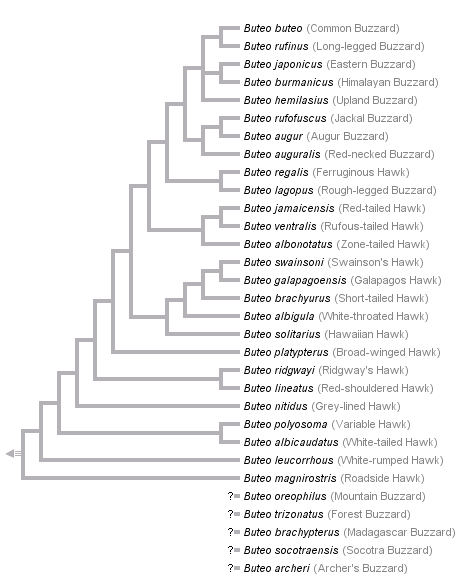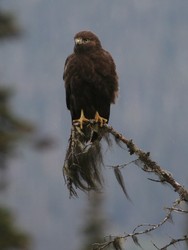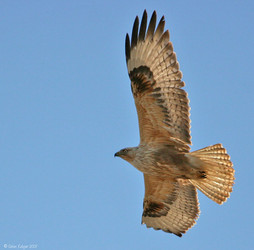Buteo
Julia Gulka and David P. Mindell


This tree diagram shows the relationships between several groups of organisms.
The root of the current tree connects the organisms featured in this tree to their containing group and the rest of the Tree of Life. The basal branching point in the tree represents the ancestor of the other groups in the tree. This ancestor diversified over time into several descendent subgroups, which are represented as internal nodes and terminal taxa to the right.

You can click on the root to travel down the Tree of Life all the way to the root of all Life, and you can click on the names of descendent subgroups to travel up the Tree of Life all the way to individual species.
For more information on ToL tree formatting, please see Interpreting the Tree or Classification. To learn more about phylogenetic trees, please visit our Phylogenetic Biology pages.
close boxTopology built based on combined mitochondrial and nuclear DNA analysis of do Amaral et al. (2009) as the most complete sampling of species. Lerner et al. (2008) offers a different topology with slightly fewer species. Based on both analyses, Buteo is polyphyletic with Leucopternis, Geranoaetus melanoleucus, and Parabuteo unicinctus, suggesting the need to reassess classification of these genera. The topology includes only species currently considered to be in the Buteo genus based on the IOC World Bird List (Gill and Donsker 2011).
NOTE: According to Gill and Donsker (2011), the correct Latin name of the Himalayan Buzzard is B. burmanicus rather than B. refectus
References
do Amaral, F. S. R., M. J. Miller, L. F. Silveira, E. Bermingham, and A. Wajntal. 2006. Polyphyly of the hawk genera Leucopternis and Buteogallus (Aves, Accipitridae): multiple habitat shifts during the Neotropical buteonine diversification. BMC Evolutionary Biology 6:10.
do Amaral, F. R., F. H. Sheldon, A. Gamauf, E. Haring, M. Reising, L. F., Silveira, and A. Wajntal. 2009. Patterns and processes of diversification in the widespread and ecologically diverse avian group, the buteonine hawks (Aves, Accipitridae). Molecular Phylogenetics and Evolution 53 703-715.
Gill, F. and D. Dosker (Eds). 2011. IOC World Bird Names (version 2.9). Available t http://www.worldbirdnames.org. Accessed 25 July 2011.
Kruckenhauser, L., Haring, E., Pinsker, W., Riesing , M. J., Winkler, H., Wink, M. and Gamauf, A. 2004. Genetic vs. morphological differentiation of Old World buzzards (genus Buteo, Accipitridae). Zool. Scripta 33:197-211.
Lerner, H. R. L., M. C. Klaver, and D. P. Mindell. 2008. Molecular phylogenetics of the buteonine birds of prety (Accipitridae). The Auk 304(2): 304-315.
Riesing, M. J., Kruckenhauser, L., Gamauf, A., and Haring, E. 2003. Molecular phylogeny of the genus Buteo (Aves: Accipitridae) based on mitochondrial marker sequences. Molecular Phylogenetics and Evolution 27: 328-342.
Title Illustrations

| Scientific Name | Buteo swainsoni |
|---|---|
| Location | British Columbia, Canada |
| Specimen Condition | Live Specimen |
| Source | Swainson's Hawk _7179 |
| Source Collection | Flickr |
| Image Use |
 This media file is licensed under the Creative Commons Attribution-NonCommercial-NoDerivs License - Version 2.0. This media file is licensed under the Creative Commons Attribution-NonCommercial-NoDerivs License - Version 2.0.
|
| Copyright | © 2006 Jean-Guy |
| Scientific Name | Buteo rufinus |
|---|---|
| Location | Golbasi/ Ankara / Turkey |
| Comments | Long-legged Buzzard |
| Specimen Condition | Live Specimen |
| Copyright |
© Selen Ediger

|
| Scientific Name | Buteo lineatus |
|---|---|
| Location | Austin, Texas, USA |
| Specimen Condition | Live Specimen |
| Source | Red Shouldered Hawk |
| Source Collection | Flickr |
| Image Use |
 This media file is licensed under the Creative Commons Attribution-NonCommercial-NoDerivs License - Version 2.0. This media file is licensed under the Creative Commons Attribution-NonCommercial-NoDerivs License - Version 2.0.
|
| Copyright | © 2006 Ananda Debnath |
About This Page

Middlebury College, Middlebury, Vermont, USA
David P. Mindell

California Academy of Sciences, San Francisco, California, USA
Correspondence regarding this page should be directed to Julia Gulka at and David P. Mindell at
Page copyright © 2011
 Page: Tree of Life
Buteo.
Authored by
Julia Gulka and David P. Mindell.
The TEXT of this page is licensed under the
Creative Commons Attribution-NonCommercial License - Version 3.0. Note that images and other media
featured on this page are each governed by their own license, and they may or may not be available
for reuse. Click on an image or a media link to access the media data window, which provides the
relevant licensing information. For the general terms and conditions of ToL material reuse and
redistribution, please see the Tree of Life Copyright
Policies.
Page: Tree of Life
Buteo.
Authored by
Julia Gulka and David P. Mindell.
The TEXT of this page is licensed under the
Creative Commons Attribution-NonCommercial License - Version 3.0. Note that images and other media
featured on this page are each governed by their own license, and they may or may not be available
for reuse. Click on an image or a media link to access the media data window, which provides the
relevant licensing information. For the general terms and conditions of ToL material reuse and
redistribution, please see the Tree of Life Copyright
Policies.
- First online 06 August 2011
- Content changed 06 August 2011
Citing this page:
Gulka, Julia and David P. Mindell. 2011. Buteo. Version 06 August 2011 (temporary). http://tolweb.org/Buteo/57807/2011.08.06 in The Tree of Life Web Project, http://tolweb.org/











 Go to quick links
Go to quick search
Go to navigation for this section of the ToL site
Go to detailed links for the ToL site
Go to quick links
Go to quick search
Go to navigation for this section of the ToL site
Go to detailed links for the ToL site